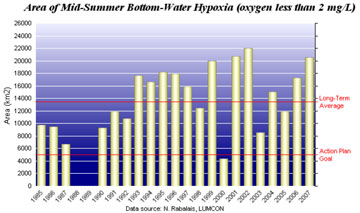U.S. dead zones may reach record levels this summer
U.S. dead zones may reach record levels this summer
mongabay.com
July 15, 2008
“Dead zones” in the Gulf of Mexico and Chesapeake Bay will likely expand to record levels this summer due to rising rising agricultural runoff in part triggered by large-scale flooding in the Midwest, according to a forecast by a researcher from the University of Michigan.
Donald Scavia, a professor at the University of Michigan’s School of Natural Resources and Environment, uses models driven by nutrient load estimates from the U.S. Geological Survey to makes the annual forecast.
Scavia predicts that Chesapeake Bay’s summer dead zone will be 9.9 cubic kilometers (2.4 cubic miles), the sixth-highest on record, although if the area of low oxygen reaches the upper value of the forecast range of 12.3 cubic kilometers (3 cubic miles), it will be the highest on record.

The Gulf of Mexico hypoxic zone (i.e., the area of bottom water with oxygen concentraions below 2 mg/l) is the second largest human-caused zone of hypoxia in the world’s coastal waters. Important fisheries are impacted at these low oxygen levels because fish, shrimp and crabs are forced to move from their preferred habitats and animals that cannot move away die. Below is a graph (www.gulfhypoxia.net) showing the changes in hypoxic volume since routine measurement began. |
Scavia projects the dead zone in the Gulf of Mexico will cover between 21,500 and 22,500 square kilometers (8,400-8,800 square miles) of bottom waters along the Louisiana-Texas coast — an extent that would be the largest on record.
“The growth of these dead zones is an ecological time bomb,” said Scavia. “Without determined local, regional, and national efforts to control them, we are putting major fisheries at risk.” According to Scavia, the best way to shrink the dead zones is to reduce the amount of nitrogen and phosphorous flowing into these water basins.
A dead zone, or area of hypoxia, is an expanse of water so devoid of oxygen that sea life cannot live in it. In the United States, these areas usually form in spring months largely as a result from runoff of nitrogen-based fertilizers. The excess nitrogen — and phosphorous — trigger massive algal blooms. When the bloom dies, the algae sinks to the sea flood where it is broken down by bacteria. The decomposition process saps the ocean of oxygen, choking marine life. The dead zone eventually dissipates in the fall due to changes in water currents and temperatures.
This article is based on a statement from the University of Michigan







